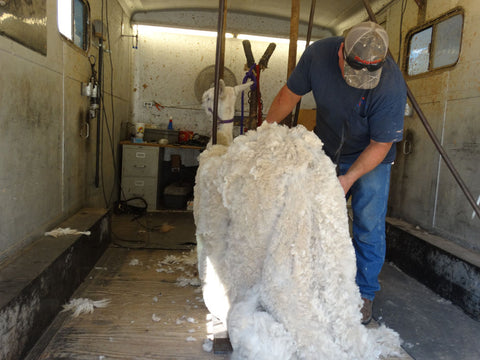Testing

This past Thursday, my wonderful vet, Dr. Michael Ridlen, came out for a morning of sample collecting. We, meaning Dr. R and his assistant Carly, pulled fecal samples from all seven goats, one alpaca and five llamas to be tested for parasite load. Dr. R also pulled a blood sample from our Welsh pony, Steele, to test his thyroid levels. Carly called me back fairly quickly with the fecal results. All the goats were negative or low enough that we don't need to treat them. Most of the camelids, however, did need to be treated. Tucker was the only llama who was negative but Shiraz, Stash, Stormy and the alpaca all needed to be wormed. I expect to hear the thyroid results next week.

Worming the goats is easy. Mostly they are wormed orally and it's easy to grab a goat by the horn and squirt the required amount of wormer in its mouth. Llamas are a different story. They are larger and stronger than a goat and they do not have the easy handle of a set of horns to grab onto. They don't like to be messed with so the very idea I want to get a rope around their neck offends them deeply. Putting a halter on them is difficult and somehow squirting the wormer into their firmly closed mouths which are held above my head is nearly impossible. It's an indication of how hardy the llamas are that in all the years I've had them I have never had to do this before. They get an injection of wormer each spring when they get sheared by my wonderful llama shearer, Sean Price. The last time I wormed them I was told to use Safeguard which is a pelleted wormer. I simply put it in their feed and didn't let them out of their stalls till they had eaten it all. This time, however, we needed to use a liquid wormer and that meant catch-halter-pry mouth open-squirt in wormer. Yikes.

We should have gotten all the worming done on Friday but I was an idiot and for some reason couldn't count all the way to four. I couldn't have gotten any of them wormed without Ron stepping in to help. Ron is walking on two titanium knees and I really didn't want him in the stall with me and five camelids but needs must as needs must. I got each animal haltered and Ron was wonderful at pushing the big guys up against the wall and holding them there while I administered the wormer. By the time we had done two llamas and one alpaca we were both exhausted. I looked in the cup of syringes and was sure all were empty so we let the llamas and alpacas go. Wrong! There was one more full syringe. Crap. By the time I figured it out the llamas were long gone up the pasture. We had to do the same dance this morning and get that last llama wormed. This time I was more confident and Ron was able to stay outside the stall. We managed it much more efficiently this time.

Thankfully we have finished worming for this round. We will test again in about 6 weeks and see who needs attention. Ron's back will feel better in a day or two and I'm happy to say his knees weathered the worming perfectly. I'm a little stiff and sore from wrestling the llamas but it all ended well.

This week got me thinking about testing in general. With the animals we test for all sorts of things. With the goats we test regularly for parasites which determines who to worm. We are testing the pony's thyroid level to verify the amount of thyroid medication he should be getting daily. We tested for rabies when my old horse Vic went from fine to very sick overnight and was exhibiting various neurologic symptoms. Vic had to be euthanized but his brain was tested for rabies. The test was negative, as expected. Of course, anytime you want to rule out a serious disease, the negative result is what you hope for.

We test many things in everyday life. We taste the spaghetti sauce to see if it needs more salt. We walk out on the porch in the morning to test the temperature to see if we need a jacket. Testing can be measuring something, tasting or smelling something, looking at something or feeling something. It can also be that first 12" of woven fabric you cut off the loom and wash to see if it has the kind of hand you want. Then as the weaver you can change something or leave it all the same. Sampling in this way assures you won't spend days and days weaving something only to find out you should have moved the warp threads closer together to make a more sturdy fabric. Or farther apart to make a softer hand. I do this all the time with a new yarn or a new pattern. Sampling is your friend. And I do it all the time with handspun yarn. I will pull out a length of single and let it ply back on itself to check out what it will look like when I'm done. Or I pull out a length of single and compare it to my sample to make sure I'm continuing to spin the same weight. This is particularly important if I'm working on a large quantity of handspun for a sweater or shawl.

Here is hoping all your tests give you A's or positive or negative or whatever you want the answer to be!
